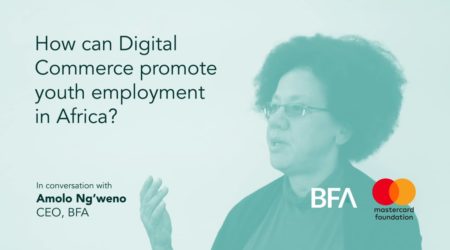iWorkers – a new bellwether of the digital economy?

How inclusive is the digital economy really? As governments and businesses around the world hasten to digitize, this is an important question. Some sound the alarm about the societal effects of jobless growth, which benefits only those endowed with high skills, or capital. Others argue that growth will inevitably create new opportunities to absorb the mass of jobseekers. The answer will clearly vary from place to place. However, we want to propose a leading indicator of the answer: namely, the financial health of ‘iWorkers’.
iWorkers are people whose livelihoods come from their connection to digital commerce platforms. They sell goods as well as services, and do so in a broad variety of forms. iWorkers encompass different groupings of emerging laborers — in different places, some are called ‘eLancers’ or ‘digital freelancers’, others are ‘gig workers’; yet others ‘e-commerce merchants’. We use ‘iWork’ both as a superset of various online work forms and also to place the emphasis on the nature of the work they are doing, and how it promotes their livelihoods.
While Uber drivers or Taobao sellers are perhaps the most iconic emblems of the iWork phenomenon today, iWorkers are already present throughout emerging economies today. Jumia, the largest e-commerce platform present in Africa today, reports some 80,000 active merchants on its site. However, this number is the tip of a much bigger ‘iceberg’ of people who are now using other digital platforms to enhance their livelihoods. BFA Global research in East and West Africa has identified a range of micro-businesses that are not yet active on e-commerce platforms like Jumia but who are using digital tools like Instagram to promote their wares, from homemade food on delivery to dressmaking, and WhatsApp to manage communications with customers. They include Moses who delivers a type of homemade stew, made according to his mother’s recipe, to office workers in Dar-es-Salaam. He reports that his order book has multiplied tenfold since he began marketing his product on Instagram. In fact, he reports also feeling the stresses of having to manage a growing microbusiness which is ‘always on’ in the digital world.
Today, it is difficult to measure the size of the iWorker segment with accuracy. Not only is the category diverse, but it includes people who may be doing the iWork part-time to supplement their income or finance their studies and are therefore subsumed under other categories of work. Surveys in the US and UK have estimated that between 1 to 4% of the labor force are ‘gig workers’, one subset of iWork, for whom this work generates most or all of their income. A recent BCG report on The New Freelancers reports that these proportions may already be much higher in emerging economies like China (12%) and India (8%), and far higher still if you include those who do iWork part-time (another 31-33%).
These swelling numbers point to the enormous supply of workers in the global south who are eager to grow and supplement their incomes using new digital tools which can connect them to new customers and new opportunities. iWork enables flexibility and greater autonomy for large segments, such as women who are mothers whose life circumstances mean that they do not fit easily into the rigid workplace cultures of fixed times and locations. However, growing numbers of iWorkers alone are not a sufficient sign of the health of labor markets in the new economy. We also need a more qualitative understanding of the livelihoods being created in this way. Research by Mark Graham and his colleagues at the Oxford Internet Institute has highlighted the risks that, for all its flexibility, some forms of iWork (such as internationally crowdsourced work) risks fueling a ‘race to the bottom’ in terms of global wage rates and conditions of work. They have set up the Fairwork Foundation as a kind of equivalent of the Fairtrade movement for digital work which will certify platforms based on how they treat their iWorkers. Steps like these and others are welcome ways of directing focus to the emerging nature of work on these platforms.
However, we see opportunities to go even further than this to enhance the livelihoods created by iWork. In many parts of the developing world, young students earn qualifications which do not provide them with onramps to the world of work. Potential employers don’t know whether to trust academic credentials, and even when they do, the information about candidate skills tends to be shallow. Employers also can’t tell from credentials alone whether the candidate has suitable capability and attitude towards work. Digital commerce platforms may integrate with training institutes to enrich the scope of credentials for workers by providing onramps by which new workers can demonstrate their capability through discrete tasks, the performance of which enters the digital record of the worker. Robust rating systems for small tasks may accumulate into profiles which attract more work and reduce the risks for employers. The work itself may not be digital: indeed, some of the most compelling opportunities may come from offline work even though it is managed and intermediated through digital platforms.
Imagine with us a sectoral application for iWorkers: a country or a region which lacks adequate community health workers because in large part of the challenges of managing a full-time public labor force of the size required. Instead, a training institute could offer training courses, whether online or in-person, which result in the credentials of successful students being entered into a section of a digital commerce platform specialized for health workers. Government or donors may fund the activities of credentialled workers on a piecework basis, using digital tools to verify the location and check the performance of the work; and pay digitally on a regular basis. Reward schemes may encourage better service outcomes. The platform may offer qualifying workers access to financial services—savings to smooth income, insurance against the loss of income, even short-term credit to bridge gaps—from regulated financial service providers. Those workers who show a consistent track record may qualify for additional benefits and rewards, such as loans or sponsorship for further training, and higher wage rates over time. Here is an example of digital innovation enhancing inclusion rather than exclusion, a race to the top instead of the bottom.
Today, that level of integration of training with the opportunity to earn a growing income seems like a dream. But the growing capabilities of digital commerce platforms tell us that it is not technologically infeasible. To be sure, it would require experimentation, coordination and demonstration. But we believe that it is through schemes like this that the financial health of iWorkers may be improved; and thereby, the genuine inclusiveness of the digital economy enhanced.
Digital work programs like this are more likely to assure that the digital economy is more inclusive. Regardless, watch out for the conditions and prospects of the tens of millions of emerging iWorkers around the world: they are a true bellwether of the inclusivity of the digital economy.


